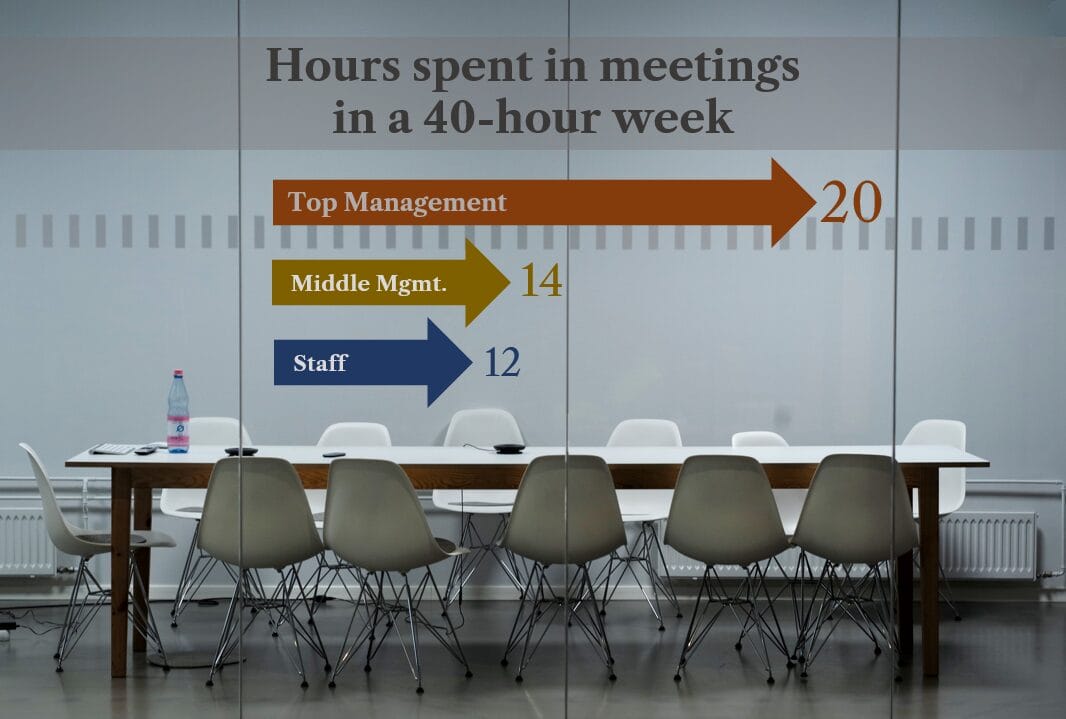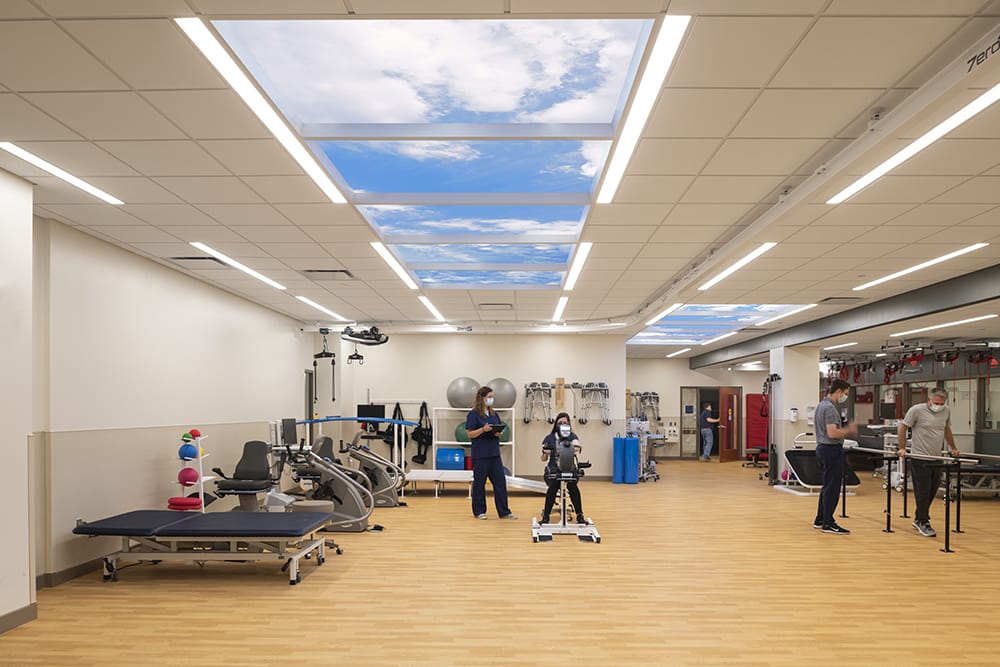Illusory Skies—Wellness for Meeting Spaces
The ongoing staff burnout epidemic has brought quiet rooms, wellness spaces, and even nap rooms back into focus. Workplaces have once again prioritized environmental design to enhance their returning staff’s job satisfaction and wellbeing. As we outlined in a feature piece for Work/Design Magazine, in the era of smart technology, among the most important architectural attributes in the workplace are Biophilic Lines of Sight.
Interiors that feature clear lines of sight to green spaces and wide open blue skies recharge cognitive function and balance the emotions throughout the day. The ability to look at a natural exterior that offers a commanding vista (prospect), enables the ultradian rhythm that governs attention to restore our focus (ultradian rhythms are recurrent periods or cycles that repeat throughout a 24-hour day). This alternation of attention between scanning a natural horizon and performing tasks that require concentration enables cognitive restoration and facilitates high productivity.
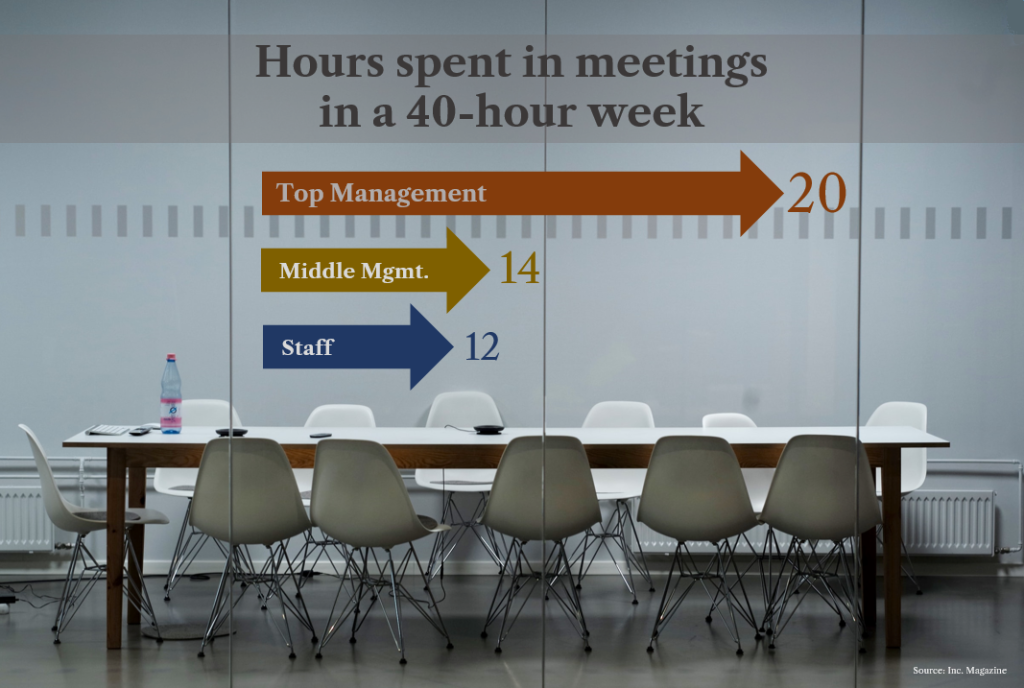
While team meetings are an important aspect of daily operations, the number of hours spent in conference rooms has risen over the years in direct relation with people’s responsibilities. Inc. magazine notes that “most people spend 12 hours of their 40-hour workweek preparing for and attending meetings.”1 However, middle managers can spend up to 35% of their time in meetings while for top managers the meeting crunch rises up to 50% of their time.
Employers eager to restore in-person teamwork are looking for ways to negotiate the hybrid work revolution by making office life more attractive. In a recent WSJ podcast, Chip Cutter, a workplace reporter for The Wall Street Journal noted that to attract and retain skilled staff, “employers realize the office needs to be more appealing. Period.”
Given that the number of meetings or their duration varies throughout the year, one aspect that companies do have control over is the physical environment. For this reason, meeting rooms are getting a much needed second look. Whenever possible they are placed in areas of the building that have restorative lines of sight.
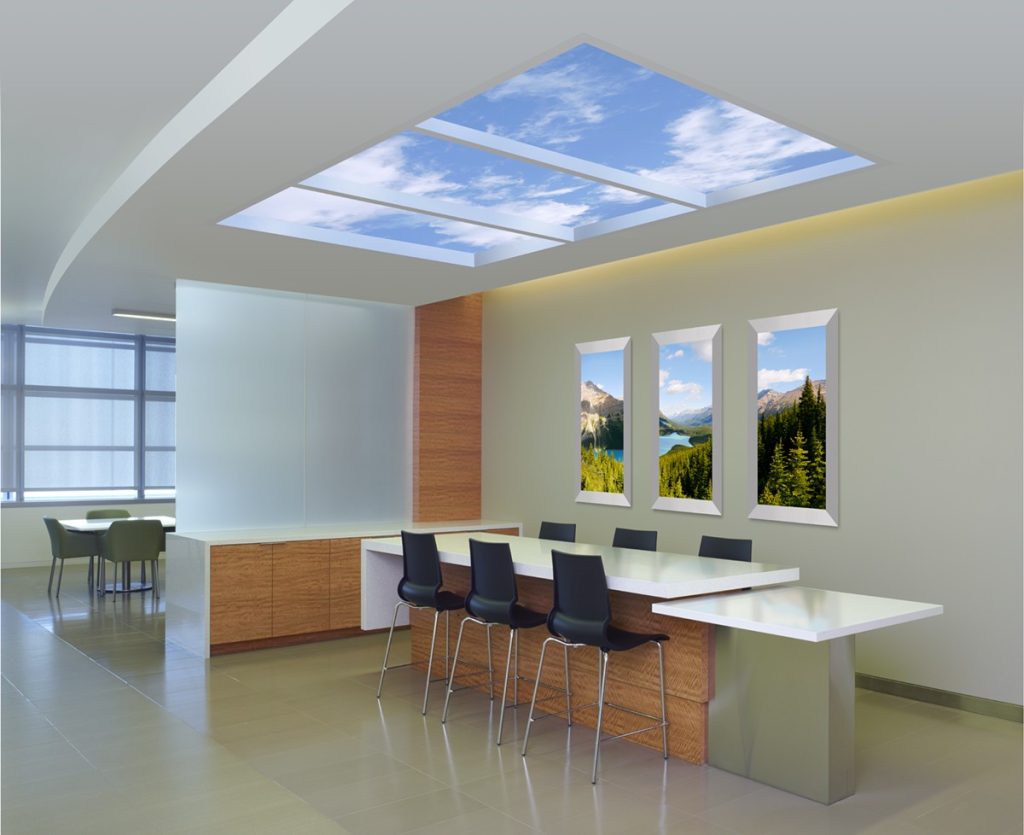
However, when this is not possible, even windowless spaces or areas with urban views that offer no respite can be outfitted with illusory skylights and window views that alter the perception of the environment in a meaningful and therapeutic manner.
“We’ve noticed an uptick in requests for SkyCeilings and Luminous Virtual Windows for office spaces or areas where staff spend most of their shift, as well as where they take their breaks,” says Skye Witherspoon, Sky Factory CEO.
“The last two years have created a wave of staff burnout across a number of industries, especially in healthcare. Many healthcare facilities are adding, revamping or otherwise upgrading their wellness rooms and staff lounges for this express purpose. No one can afford to lose a nurse or doctor over a working environment that doesn’t help them decompress,” adds Skye.
Negotiating The Great Return
Employers across the board are rethinking the office layout with an eye to making the workplace more attractive. At stake, is retention of highly skilled workers as companies that issued return-to-the-office mandates in the spring face tight labor markets.
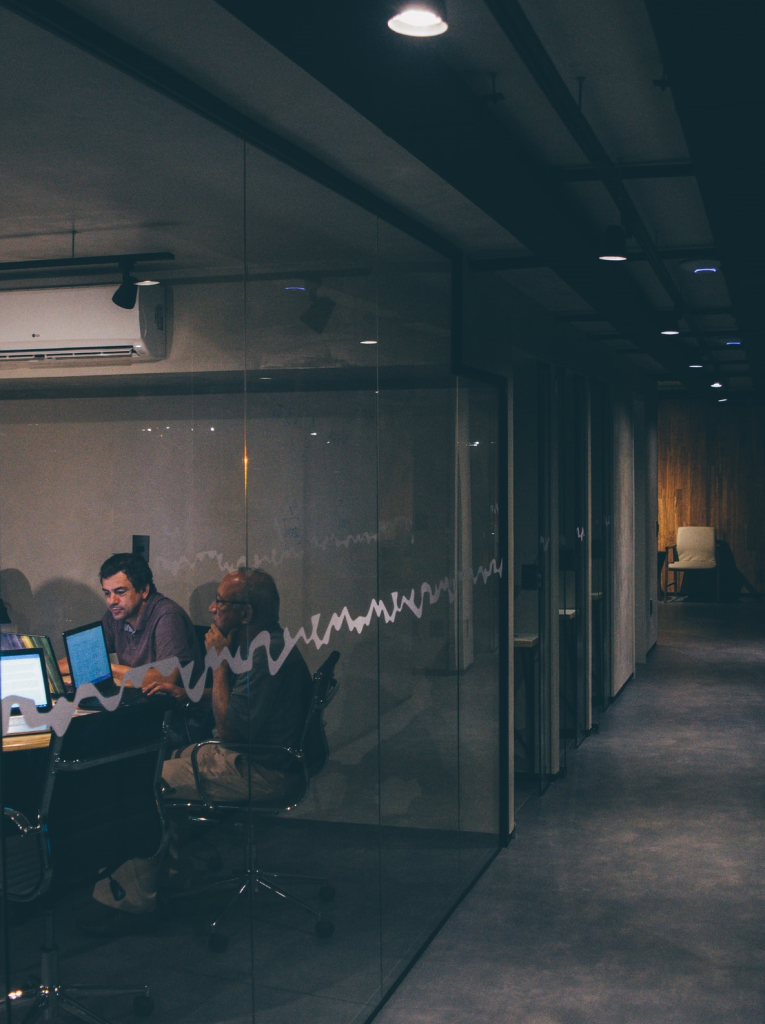
Last year, a Huffington Post survey of more than 1,000 U.S. workers found that 1 in 4 full-time employees working from home due to the pandemic would prefer to stay fully remote.2 However, the desire for remote work was plain to see almost a full decade ago. A 2013 Inc. magazine survey reported that 70% of white collar workers would favor working from home, at least, a few days per week.
One of the unexpected consequences of the two-year Covid-19 pandemic has been that legions of white collars workers experienced the welcome perks of the home office—no commute time, more flextime convenience, and access to personal comforts—not available in the traditional office.
After the wave of early retirements, employers today face tighter labor markets as more companies today offer full-time remote positions. This has put the onus on firms to spruce up the traditional office to attract and retain workers while ensuring that morale and wellness—both of which drive productivity—don’t decline as staff return to the workplace.
Mitigating Remote Meeting Burnout
Another interesting aspect of the pandemic business day that’s expected to change is the frequency of weekly meetings. According to Harvard Business School, on an average business day, American firms hold 11 million meetings. On the other hand, Inc. magazine places the figure between 36 and 56 million. While the actual number of meetings is hard to pin down, what people think of meetings is not.
The results of a new Pew Research Center survey of U.S. adults conducted last spring found that 40% of Americans reported experiencing “Zoom fatigue” or feeling worn out by the amount of time spent connecting with others remotely. The survey found that two-thirds of those surveyed (68%) said that these video calls would have otherwise taken place in person.3

Along this line, a usage analysis of Microsoft’s online video meeting application Microsoft Teams revealed that workers spent 2.5 times as many minutes per week in meetings in February 2021 versus February 2020. The data also showed that staff sent 42% more chats to each other outside of regular business hours.4
The unforeseen burnout generated by digital connectivity anytime has alerted managers that workers returning to the office will be looking for sympathetic faces and a comfortable office environment. In fact, Doodle, the online calendar tool, found that more than three-quarters of employees (76%) would rather attend in-person meetings than hold a video call.
In this context, the conference room and related collaborative spaces like cafeterias and low-key meeting lounges are long overdue for a redesign. Many of these spaces were not designed for creative work or outfitted to restore people’s mental focus by allowing decompression in quiet and pleasant surroundings.
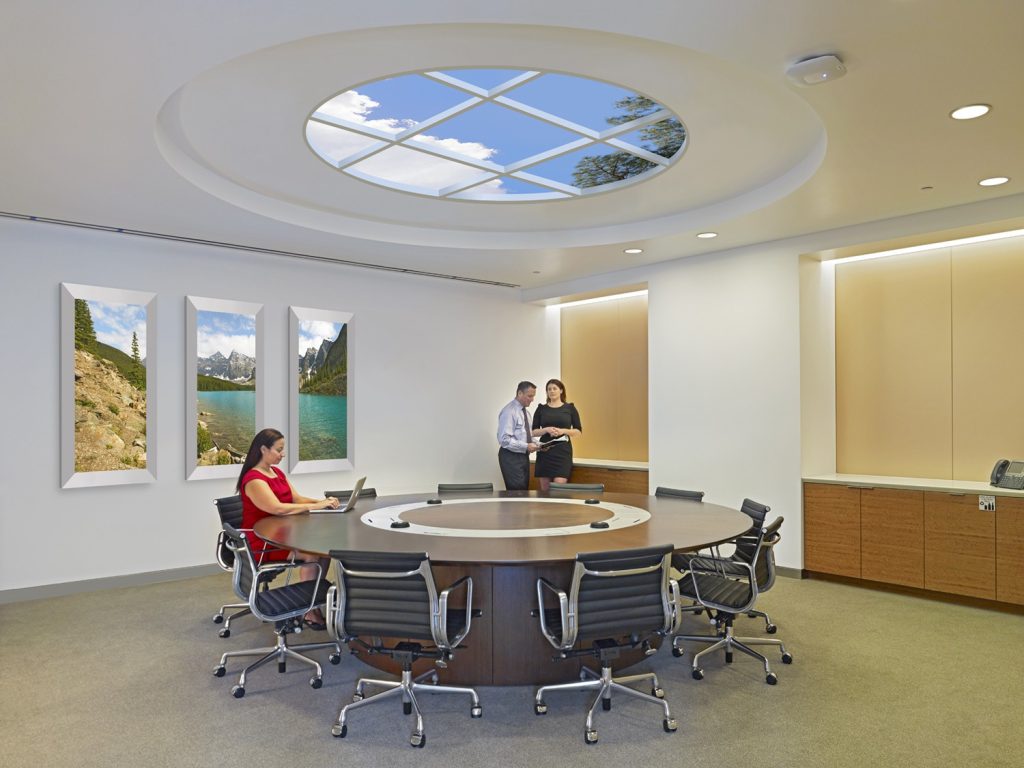
Wellness is the main driver behind consistent productivity and long-term job satisfaction. Evidence-based design tools such as bone fide illusions of nature for ceiling and wall applications can economically transform windowless or otherwise subpar work environments into spaces that enhance occupant wellness.
References
1 https://www.inc.com/john-white/ineffective-meetings-cost-companies-up-to-283-billion-a-year-streamline-collaboration-with-these-tips.html. Inc. Magazine. March 28, 2022. Retrieved from: Ineffective Meetings Cost Companies Up to $283 Billion a Year, John White,
2 Brittany Wong, 5 Worries People Are Having About Returning to the Office. Huffington Post. March 22, 2022. Retrieved from: https://www.huffpost.com/entry/going-back-to-work-worries_l_60996a69e4b0ae3c6881cca6
3 The Pew Center. The Internet and the Pandemic. September 1st, 2021. Retrieved from: https://www.pewresearch.org/internet/2021/09/01/the-internet-and-the-pandemic/
4 Work Trend Index: 2021 Annual Report. The Next Great Disruption is Hybrid Work—Are We Ready? Microsoft, Inc. September 2021. Retrieved from: https://pulse.microsoft.com/uploads/prod/2021/09/2021-Work-Trend-Index-Annual-Report-Presentation-1.pdf

